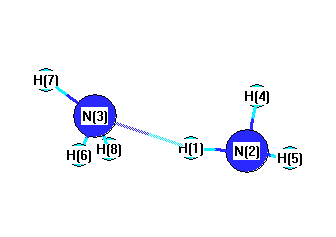Vibrational Frequencies calculated at PBEPBEultrafine/6-311+G(3df,2pd)
| Mode Number |
Symmetry |
Frequency
(cm-1) |
Scaled Frequency
(cm-1) |
IR Intensities
(km mol-1) |
Raman Act
(Å4/u) |
Dep P |
Dep U |
|---|
| 1 |
A' |
3517 |
3482 |
6.52 |
|
|
|
| 2 |
A' |
3465 |
3430 |
50.71 |
|
|
|
| 3 |
A' |
3396 |
3362 |
4.40 |
|
|
|
| 4 |
A' |
3324 |
3291 |
147.16 |
|
|
|
| 5 |
A' |
1620 |
1604 |
16.22 |
|
|
|
| 6 |
A' |
1610 |
1594 |
12.38 |
|
|
|
| 7 |
A' |
1051 |
1041 |
97.76 |
|
|
|
| 8 |
A' |
1038 |
1027 |
144.18 |
|
|
|
| 9 |
A' |
381 |
377 |
51.01 |
|
|
|
| 10 |
A' |
138 |
136 |
18.08 |
|
|
|
| 11 |
A' |
96 |
95 |
56.46 |
|
|
|
| 12 |
A" |
3519 |
3484 |
5.73 |
|
|
|
| 13 |
A" |
3513 |
3478 |
0.75 |
|
|
|
| 14 |
A" |
1644 |
1627 |
8.01 |
|
|
|
| 15 |
A" |
1618 |
1601 |
19.17 |
|
|
|
| 16 |
A" |
264 |
261 |
35.25 |
|
|
|
| 17 |
A" |
124 |
123 |
35.44 |
|
|
|
| 18 |
A" |
33 |
32 |
14.64 |
|
|
|
Unscaled Zero Point Vibrational Energy (zpe) 15174.2 cm
-1
Scaled (by 0.99) Zero Point Vibrational Energy (zpe) 15022.5 cm
-1
See section
III.C.1 List or set vibrational scaling factors
to change the scale factors used here.
See section
III.C.2
Calculate a vibrational scaling factor for a given set of molecules
to determine the least squares best scaling factor.
Charges, Dipole, Quadrupole and Polarizability
Charges from optimized geometry at PBEPBEultrafine/6-311+G(3df,2pd)
Charges (e)
| Number |
Element |
Mulliken |
CHELPG |
AIM |
ESP |
| 1 |
H |
0.215 |
|
|
|
| 2 |
N |
-0.366 |
|
|
|
| 3 |
N |
-0.281 |
|
|
|
| 4 |
H |
0.078 |
|
|
|
| 5 |
H |
0.078 |
|
|
|
| 6 |
H |
0.104 |
|
|
|
| 7 |
H |
0.086 |
|
|
|
| 8 |
H |
0.086 |
|
|
|
Electric dipole moments
Electric dipole components in Debye
(What's a Debye? See section
VII.A.3)
| |
x |
y |
z |
Total |
| |
0.925 |
-2.337 |
0.000 |
2.514 |
| CHELPG |
|
|
|
|
| AIM |
|
|
|
|
| ESP |
|
|
|
|
Electric Quadrupole moment
Quadrupole components in D Å
Polarizabilities
Components of the polarizability tensor.
Units are
Å
3 (Angstrom cubed)
Change units.
| |
x |
y |
z |
| x |
0.000 |
0.000 |
0.000 |
| y |
0.000 |
0.000 |
0.000 |
| z |
0.000 |
0.000 |
0.000 |
<r2> (average value of r
2) Å
2
| <r2> |
70.662 |
| (<r2>)1/2 |
8.406 |
